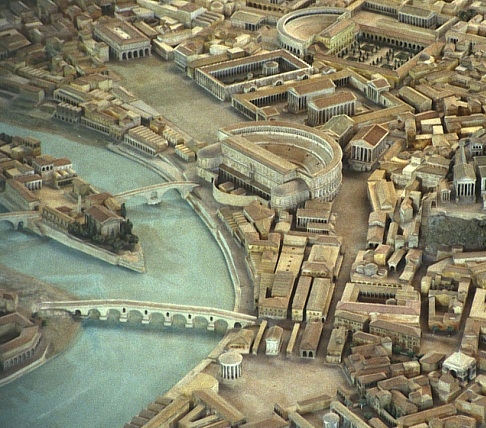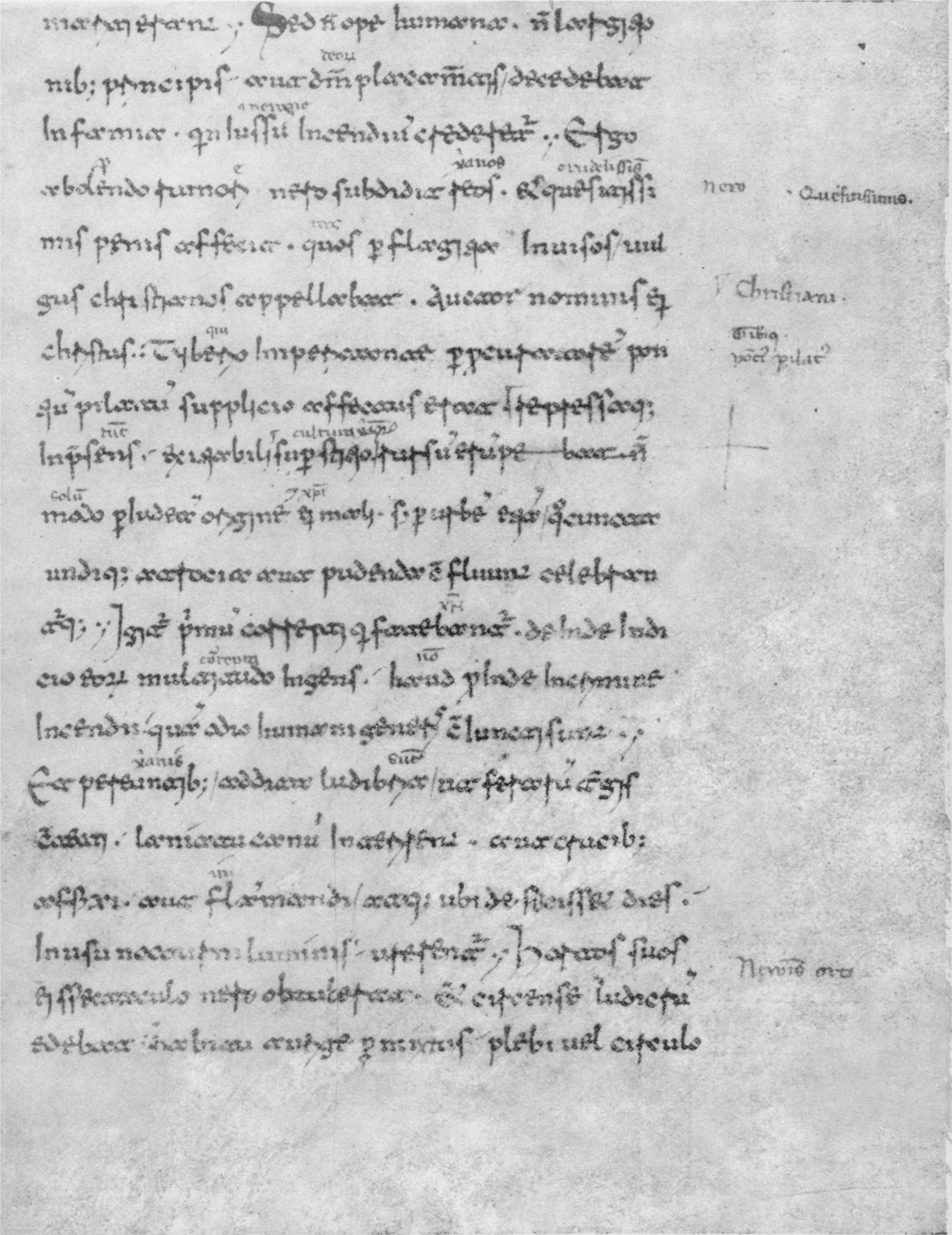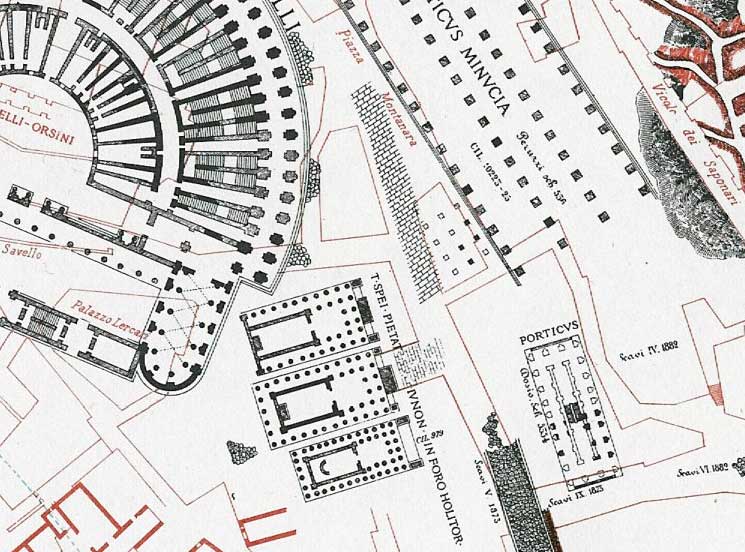|
San Nicola In Carcere
San Nicola in Carcere (Italian, " St Nicholas in prison") is a titular church in Rome near the Forum Boarium in rione Sant'Angelo. It is one of the traditional stational churches of Lent. History The first church on the site was probably built in the 6th century, and a 10th-century inscription may be seen on a fluted column next to the entrance, but the first definite dedication is from a plaque on the church dating to 1128. The inscriptions found in S. Angelo, a valuable source illustrating the history of the Basilica, have been collected and published by Vincenzo Forcella. It was constructed in and from the ruins of the Forum Holitorium and its Roman temples, along with a jail (carcer) which a tradition (supported by Pliny's history of Rome) states was sited in the temples' ruins. However, the ''in Carcere'' (in jail) part of the name of the church was only changed to "in Carcere Tulliano" in the 14th century, owing to an erroneous identification. The prison was really that ... [...More Info...] [...Related Items...] OR: [Wikipedia] [Google] [Baidu] |
Theatre Of Marcellus
The Theatre of Marcellus ( la, Theatrum Marcelli, it, Teatro di Marcello) is an ancient open-air theatre in Rome, Italy, built in the closing years of the Roman Republic. At the theatre, locals and visitors alike were able to watch performances of drama and song. Today its ancient edifice in the rione of Sant'Angelo, Rome, once again provides one of the city's many popular spectacles or tourist sites. Space for the theatre was cleared by Julius Caesar, who was murdered before its construction could begin; the theatre was advanced enough by 17 BC that part of the celebration of the ''ludi saeculares'' took place within the theatre; it was completed in 13 BC and formally inaugurated in 12 BC by Augustus,Leland M. Roth 1993 ''Understanding Architecture: Its Elements, History and Meaning'' (Westview Press: Boulder, CO and Cassius Dio 53.30.5., pp 230-31 named after his nephew Marcus Claudius Marcellus who had died in 23 BC. The theatre was 111 m in diameter and was the largest and ... [...More Info...] [...Related Items...] OR: [Wikipedia] [Google] [Baidu] |
Forum Holitorium
The Forum Holitorium ( it, Foro Olitorio; en, Vegetable-sellers' Market) is an archaeological area of Rome, Italy, on the slopes of the Capitoline Hill. It was "oddly located" outside the Porta Carmentalis in the Campus Martius, crowded between the Forum Boarium ("Cattle Market") and buildings located in the Circus Flaminius. In ancient times it was the fruit and vegetable market, while the area of the adjacent Forum Boarium served as meat market. It also included a sacred area with three small temples dedicated to Janus, Spes and Juno Sospita. The sacred area The construction of the sacred area of the forum dates back to the Republican age, more precisely to the period between the first and the second Punic War. Subsequently, at the time of Caesar ( 1st century BC), it underwent renovations which involved the demolition of a fourth temple: it was built by Manius Acilius Glabrio (consul in 191 BC) next to the Temple of Janus and was demolished during the construction of the T ... [...More Info...] [...Related Items...] OR: [Wikipedia] [Google] [Baidu] |
Pierleoni Family
The family of the Pierleoni, meaning "sons of Peter Leo", was a great Roman patrician clan of the Middle Ages, headquartered in a tower house in the quarter of Trastevere that was home to a larger number of Roman Jews. The heads of the family often bore the title ''consul Romanorum'', or "Consul of the Romans," in the early days. The family descended from the eleventh-century Jewish convert Leo de Benedicto, whose baptismal name comes from the fact that he was baptised by Pope Leo IX himself.The original convert, according to th''Jewish Encyclopedia'', "Pierleoni,"would have been his father, taking the name ''Benedictus Christianus'' ("Blessed Christian"), hence, in the usual way, his son Leo de Benedicto. They also were bankers and financially backed the reform papacy. While the Pierleoni during their greatness spuriously claimed to be descended from the ancient Roman noble family of the Anicii, their enemies in Rome made much of their Jewish extraction and levelled the usual char ... [...More Info...] [...Related Items...] OR: [Wikipedia] [Google] [Baidu] |
Pier Leoni
Pier Leoni (or Pierleone) ( la, Petrus Leo or ) (died 2 June 1128) was the son of the Jewish convert Leo de Benedicto and founder of the great and important medieval Roman family of the Pierleoni. He was called the Jewish Crassus by Gregorovius. Pierleone himself was a consul of the eternal city in the early twelfth century. He was one of the regents of the city itself when Pope Paschal II left in 1108 to deal with raising troops. "Rome remained the pit of daily rebellion," as Gregorovius says. In 1111, Pierleone negotiated the imperial coronation of the Emperor Henry V. Ever a faithful ally of the pope, in 1117, he retook Rome for him, but was subsequently holed up in his tower by Ptolemy I of Tusculum. After the election of Bishop John of Gaeta as Gelasius II on 24 January 1118, the new pope was thrown into prison by Cencio II Frangipane. It was Pierleone, with his son Peter, Peter the prefect of the city, and the papal gonfalonier Stephen the Norman, who restored the pope' ... [...More Info...] [...Related Items...] OR: [Wikipedia] [Google] [Baidu] |
Annals (Tacitus)
The ''Annals'' ( la, Annales) by Roman historian and senator Tacitus is a history of the Roman Empire from the reign of Tiberius to that of Nero, the years AD 14–68. The ''Annals'' are an important source for modern understanding of the history of the Roman Empire during the 1st century AD; it is Tacitus' final work, and modern historians generally consider it his greatest writing. Historian Ronald Mellor (historian), Ronald Mellor calls it "Tacitus's crowning achievement", which represents the "pinnacle of Roman historical writing". Tacitus' Histories (Tacitus), ''Histories'' and ''Annals'' together amounted to 30 books; although some scholars disagree about which work to assign some books to, traditionally 14 are assigned to ''Histories'' and 16 to ''Annals''. Of the 30 books referred to by Jerome about half have survived. Modern scholars believe that as a Roman senator, Tacitus had access to ''Acta Senatus''—the Roman senate's records—which provided a solid basis for hi ... [...More Info...] [...Related Items...] OR: [Wikipedia] [Google] [Baidu] |
Tacitus
Publius Cornelius Tacitus, known simply as Tacitus ( , ; – ), was a Roman historian and politician. Tacitus is widely regarded as one of the greatest Roman historiography, Roman historians by modern scholars. The surviving portions of his two major works—the Annals (Tacitus), ''Annals'' (Latin: ''Annales'') and the Histories (Tacitus), ''Histories'' (Latin: ''Historiae'')—examine the reigns of the Roman emperor, emperors Tiberius, Claudius, Nero, and those who reigned in the Year of the Four Emperors (69 AD). These two works span the history of the Roman Empire from the death of Augustus (14 AD) to the death of Domitian (96 AD), although there are substantial Lacuna (manuscripts), lacunae in the surviving texts. Tacitus's other writings discuss Public speaking, oratory (in dialogue format, see ''Dialogus de oratoribus''), Germania (in Germania (book), ''De origine et situ Germanorum''), and the life of his father-in-law, Gnaeus Julius Agricola, Agricola (t ... [...More Info...] [...Related Items...] OR: [Wikipedia] [Google] [Baidu] |
Battle Of Mylae
The Battle of Mylae took place in 260 BC during the First Punic War and was the first real naval battle between Carthage and the Roman Republic. This battle was key in the Roman victory of Mylae (present-day Milazzo) as well as Sicily itself. It also marked Rome's first naval triumph and also the first use of the ''corvus'' in battle.Tacitus, The Annals 2.49 Prelude Inspired by success in the battle of Agrigentum, the Romans sought to win all of Sicily, but required naval power to do so. In order to challenge the already prominent Carthaginian naval forces, Rome built a fleet of one hundred quinqueremes and twenty triremes.Polybius, ''The General History of Polybius,'' Book I, p. 24 The famous Greek historian Polybius wrote that Rome used a wrecked Carthaginian quinquereme captured at Messina as a model for the entire fleet, and that the Romans would have otherwise had no basis for design.Polybius, ''The General History of Polybius,'' Book I, p. 25 However, this may have been a ... [...More Info...] [...Related Items...] OR: [Wikipedia] [Google] [Baidu] |
Gaius Duilius
Gaius Duilius ( 260–231 BC) was a Roman general and statesman. As consul in 260 BC, during the First Punic War, he won Rome's first ever victory at sea by defeating the Carthaginians at the Battle of Mylae. He later served as censor in 258, and was appointed dictator to hold elections in 231, but never held another command. Background Gaius Duilius, whose father and grandfather were both named Marcus Duilius, belonged to a undistinguished family. One Caeso Duilius is recorded as consul in 336 BC, but the surname is otherwise only known historically and reliably from a few minor magistrates in the fourth century BC. Career Naval victory Duilius was one of the consuls for the year 260 BC, and was initially appointed to command Rome's land forces in Sicily against Carthage, as part of the First Punic War. His colleague in office, Gnaeus Cornelius Scipio, held charge of the fleet. The Romans built 120 warships and despatched them to Sicily in 260 BC for their crews to carry ... [...More Info...] [...Related Items...] OR: [Wikipedia] [Google] [Baidu] |
Temple Of Janus (Forum Holitorium)
The Temple of Janus at the Forum Holitorium is the second known temple dedicated to Janus, besides the temple of the same name located in the Roman Forum. It is known that it stood "close to the Theatre of Marcellus" (''ad theatrum Marcelli'' or ''iuxta theatrum Marcelli'') and "outside Porta Carmentalis" (''extra portam Carmentalem'') and that feasts took place there in August and October. It is highly likely that it is one of the three contiguous temples from the Republican era in the area of the ancient Forum Holitorium – where now stands the church of S. Nicola in Carcere – and more specifically the northernmost one, to the right than the facade of the church. The remains of the temple are seven columns in tuff - a material typical of the original age of construction and of the Roman tradition - incorporated with their architrave in the right side of the church and two columns rising on the basement just near the Theatre of Marcellus. History The temple was built by ... [...More Info...] [...Related Items...] OR: [Wikipedia] [Google] [Baidu] |
Temple Of Juno Sospita
A temple (from the Latin ) is a building reserved for spiritual rituals and activities such as prayer and sacrifice. Religions which erect temples include Christianity (whose temples are typically called churches), Hinduism (whose temples are called Mandir), Buddhism, Sikhism (whose temples are called gurudwara), Jainism (whose temples are sometimes called derasar), Islam (whose temples are called mosques), Judaism (whose temples are called synagogues), Zoroastrianism (whose temples are sometimes called Agiary), the Baha'i Faith (which are often simply referred to as Baha'i House of Worship), Taoism (which are sometimes called Daoguan), Shinto (which are sometimes called Jinja), Confucianism (which are sometimes called the Temple of Confucius), and ancient religions such as the Ancient Egyptian religion and the Ancient Greek religion. The form and function of temples are thus very variable, though they are often considered by believers to be, in some sense, the "hous ... [...More Info...] [...Related Items...] OR: [Wikipedia] [Google] [Baidu] |
Spolia
''Spolia'' (Latin: 'spoils') is repurposed building stone for new construction or decorative sculpture reused in new monuments. It is the result of an ancient and widespread practice whereby stone that has been quarried, cut and used in a built structure is carried away to be used elsewhere. The practice is of particular interest to historians, archaeologists and architectural historians since the gravestones, monuments and architectural fragments of antiquity are frequently found embedded in structures built centuries or millennia later. The archaeologist Philip A. Barker gives the example of a late Roman period (probably 1st-century) tombstone from Wroxeter that could be seen to have been cut down and undergone weathering while it was in use as part of an exterior wall and, possibly as late as the 5th century, reinscribed for reuse as a tombstone. Overview The practice was common in late antiquity. Entire obsolete structures, including underground foundations, are known to ... [...More Info...] [...Related Items...] OR: [Wikipedia] [Google] [Baidu] |
Rom BW 1
Rom, or ROM may refer to: Biomechanics and medicine * Risk of mortality, a medical classification to estimate the likelihood of death for a patient * Rupture of membranes, a term used during pregnancy to describe a rupture of the amniotic sac * Range of motion, e.g. of joints in physiotherapy Computers and mathematics * Read-only memory, a type of storage media that is used in computers and other electronic devices ** ROM cartridge, a portable form of read-only memory ** ROM image, a computer file which contains a copy of the data from a read-only memory chip * Random oracle model, a mathematical abstraction used in cryptographic proofs * ROM (MUD), a popular MUD codebase * Request of Maintainer (see Software maintainer) Engineering * Range of motion, the distance that a movable object may normally travel while properly attached to another object * RFID on metal, refers to radio-frequency identification (RFID) tags which perform a specific function when attached to metal ob ... [...More Info...] [...Related Items...] OR: [Wikipedia] [Google] [Baidu] |





.jpg)